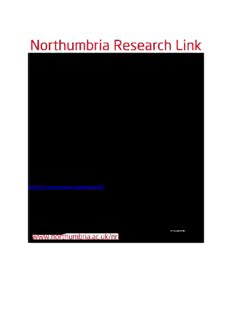
Citation: Novaco, Raymond and Taylor, John (2008) Anger and assaultiveness of male forensic ... PDF
Preview Citation: Novaco, Raymond and Taylor, John (2008) Anger and assaultiveness of male forensic ...
Citation: Novaco, Raymond and Taylor, John (2008) Anger and assaultiveness of male forensic patients with developmental disabilities : links to volatile parents. Aggressive Behavior, 34 (4). pp. 380-393. ISSN 0096-140X Published by: Wiley-Blackwell URL: http://dx.doi.org/10.1002/ab.20254 <http://dx.doi.org/10.1002/ab.20254> This version was downloaded from Northumbria Research Link: http://nrl.northumbria.ac.uk/3689/ Northumbria University has developed Northumbria Research Link (NRL) to enable users to access the University’s research output. Copyright © and moral rights for items on NRL are retained by the individual author(s) and/or other copyright owners. Single copies of full items can be reproduced, displayed or performed, and given to third parties in any format or medium for personal research or study, educational, or not-for-profit purposes without prior permission or charge, provided the authors, title and full bibliographic details are given, as well as a hyperlink and/or URL to the original metadata page. The content must not be changed in any way. Full items must not be sold commercially in any format or medium without formal permission of the copyright holder. The full policy is available online: http://nrl.northumbria.ac.uk/policies.html This document may differ from the final, published version of the research and has been made available online in accordance with publisher policies. To read and/or cite from the published version of the research, please visit the publisher’s website (a subscription may be required.) RunningHead:VOLATILEPARENTSAND FORENSIC PATIENTS'ANGER Angerand AssaultivenessofMaleForensicPatientswith DevelopmentalDisabilities:LinkstoVolatileParents Raymond W. Novaco UniversityofCalifornia, Irvine John L.Taylor NorthumbriaUniversity Northumberland,Tyne& Wear NHSTrust AggressiveBehavior,34,380-393 Correspondence: Raymond W.Novaco, Ph.D. Departmentof Psychologyand SocialBehavior UniversityofCalifornia, Irvine Irvine,CA 92697-7085 [email protected] VolatileParents 2 Abstract This studywith107maleforensicpatientswithdevelopmentaldisabilitiesinvestigated whetherexposuretoparentalangerand aggressionwas relatedtoangerand assaultivenessin hospital,controllingforbackgroundvariables. Patientangerand aggressionwasassessedby self-report,staff-ratings,andarchivalrecords. Exposuretoparentalanger/aggression,assessed byclinicalinterview,wassignificantlyrelatedto patientself-reportedanger,staff-rated anger andaggression, andphysicalassaults inhospital,controllingforage, IQ,lengthofhospitalstay, violentoffensehistory,andchildhoodphysicalabuse. Results areconsonantwithprevious findings concerningdetrimentaleffects ofwitnessingparentalviolenceand withtheoryon acquisitionofcognitivescripts foraggression. Implicationsforclinicalassessmentandcognitive restructuringinangertreatment arediscussed. Keywords: anger,aggression,parentalviolence,hospitalpatients,developmentaldisabilities VolatileParents 3 AngerandAssaultivenessofMaleForensicPatients withDevelopmentalDisabilities: LinkstoVolatileParents Fromchildhoodonward, thelifecircumstancesandpsychosocialexperiencesofpeople withdevelopmentaldisabilities1areconducivetotheactivationofangerandaggressive behavior. Recurrentthwartingofphysical,emotional,andinterpersonalneeds,aswellas cognitivefunctioningdeficits,impairtheirpsychosocialadjustment,particularlythosewho resideincustodialsettings.Thepresentstudyexamineswhethertheangerandaggressive behaviorofhospitalized maleoffenderswithdevelopmentaldisabilitiesarerelatedtochildhood experiencesofparentalangerandparentalfighting,as wellastoabusevictimization. We pursue thisresearchquestionwithaneyetowarditsbroadertheoreticalrelevanceforangerand aggression,aswellasitsimplicationsconcerningassessmentandtreatment. Epidemiologicalstudies onthreecontinents concerningpeoplewithdevelopment disabilities havefoundhighratesof“challengingbehaviour”,inwhich aggressionfeatures prominently(Harris,1993;Hill&Bruininks,1984;Sigafoos,Elkins, Kerr, &Attwood,1994; Smith,Branford,Collacott,Cooper,&McGrother,1996).Theprevalenceofphysicalaggression inthesestudiesis 35%orhigher forpersonsininstitutionalsettings,and,forthemalepatientsin thepredominantlyforensicfacilityinvolvedinthepresentstudy,NovacoandTaylor(2004) foundphysicallyassaultivebehaviorpost-admissiontobe46.5%. Importantly,thelatterstudy foundthatthenumberof assaultswassignificantlyrelatedtoanger,controllingforage,lengthof stay,IQ,violentoffensehistory,andpersonalityvariables. Therelevance ofangerand aggressionforpersonswithdevelopmentaldisabilitiesisreviewedinTaylorandNovaco(2005). Here, weexaminefamilybackgroundvariablesthatmightaccountfor angerdispositionand aggressivebehavioramongthoseinthis clinicalpopulation. VolatileParents 4 InterparentalVolatilityandChildAdjustment Thewitnessingofinterparentalangerorinteradultdomesticviolencehas consistently beenfoundtobedetrimentaltochildren’s well-being.Cummings andhiscolleagueshaveshown repeatedlyinlab experimentalstudiesthatchildrendisplayheightenedsensitivityand emotional distresstoangryadultinteractions,especiallywhenthereisinteradultphysicalaggression(e.g., Cummings,Ballard, &El-Sheikh,1991;Cummings,Zahn-Waxler, &Radke-Yarrow,1981; Davies,Myers,Cummings, &Heindel,1999;El-Sheikh,Cummings, &Goetsch,1989). In a home-baseddiarystudy,Cummings,Goeke-Morey, Papp,and Dukewich (2002)foundthat,in responseto maritalconflictepisodes,childangerwassignificantlyrelated tobothmothers’and fathers’anger,particularlythatoffathers. Substantialfieldresearchconcerningchildren who havewitnessed familyviolencehas identifiedassociatedpsychological maladjustment,including posttraumaticstresssymptoms (Fantuzzo etal.,1991; Kilpatrick& Williams,1998;Jarvis, Gordon,&Novaco,2005;McCloskey& Walker, 2000; O'Keefe,1994;Rossman &Ho,2000; Silvaetal.,2000)andbehaviorproblems(Grych etal.,2000;Jarvisetal.,2005;Jarvis& Novaco,2006; Litrownik,Newton,Hunter,English,&Everson,2003;Mathias,Merton,& Murray,1995). Witnessingadultangryconflictitself(separatefromwitnessingviolencetoward afamilymember)presentsriskforchildadjustmentproblems,asshownin alargesamplestudy concerningtoddlers(McDonald,Jouriles,Briggs-Gowan,Rosenfield, &Carter,2007). Interparentalaggression andparentalaggressiontowardchildrenoftenco-occurin families(cf.O’Leary,Slep,&O’Leary,2000).The Kitzmann,Gaylord, Holt,andKenny(2003) meta-analysis foundnodifferencesineffectsizes foroverallpsychologicaladjustmentbetween witness-onlychildren,abused-onlychildren,and abused-witnesses,butseveralstudieshave reportedthat childrenwhoarebothwitnessestoanddirecttargetsofabuse faresignificantly VolatileParents 5 worsethanchildrenwho aresolelywitnesses (e.g.,Grychetal.,2000; Mathiasetal.,1995; McCloskey& Walker,2000). Inaddition,exposuretomoresevereinteradultabusehasbeen associatedwithhigherlevels ofchildbehavioralproblems andtraumasymptoms(Fantuzzo et al.,1991;Jarvis,etal.,2005;O’Keefe,1994;Rossman &Ho,2000). Ina longitudinalstudy withmultipleinformantsthatcontrolledforchildabuseandneglect(as wellaschild IQ, householdSES,andfamilylifestress),Yates, Dodds,Sroufe,andEgeland(2003)foundthat exposuretopartnerviolenceduringpreschool yearswasassociatedwithexternalizingproblems forboys inadolescence. Strickler(2001)asserted thatpersons withintellectualdisabilityhavehigherriskforchild abuseanddomesticviolenceexposure.Compared topersons withaveragegeneralintellectual functioning,theirhigherdependency,frequentdenialofrights,moreisolatedlivingconditions, communicationproblems,lackof knowledgeaboutappropriatebehavior,physicalimpairments, andlackof economicindependenceheightenstheirvulnerability. Epidemiologicalresearchon twinpairs (sampledfrom1994and1995birthcohorts inEngland)byKoenen,Moffitt,Caspi, Taylor,and Purcell(2003)demonstratedthatdomesticviolencewas uniquelyassociatedwith IQ suppressionindose-responserelationship.Thus,domesticviolenceexposuremayexacerbate cognitivefunctioningimpairmentpresentatbirth. HuesmannandEron(1984),inworkthat presagedthesocialinformationprocessingconstructwediscusslater, foundthatdiminished intellectualcompetencewasassociatedwiththeearlyadoptionofaggressivestrategiesas achild thatpersistovertimeand arepredictiveoflowerintellectualfunctioningas anadult. Thefamilyenvironmentrootsofangerandaggressivebehaviorhavebeen aresearch psychologytopicsincetheclassicworkofGoodenough(1931),Sears,Maccoby, and Levin (1957),and McCord, McCord,andHoward(1961,1963).Thelatter authorsconcludedthat VolatileParents 6 aggressiveboyswere raisedbyparentswho wererejectingandpunitive,weremodelsofdeviant, aggressivebehavior,and wereofteninvolvedinintenseinterparentalconflict. Similarly,in Farrington’s(1989)longitudinalresearch,adult males convictedofviolentoffenseshad, atage8, parents characterizedbycruelattitudes,harshdiscipline,andinterparentalconflict. Parental disharmonyduringadolescence wasalsopredictiveofconvictions forviolence,as waslowIQ. Takentogether,thisbodyofresearchindicates that children’s exposuretointerparental angerand aggressioncanbeexpectedtoincreasetheirriskofhavingadjustmentdifficulties. AcquisitionofaDispositionfor Anger andAggression SociallearningmodelsfromBandura(1973)tothoseofDodgeandhis colleagues (e.g., Crick&Dodge,1994,1996;Dodge&Coie,1987;Dodge,Pettit,Bates,&Valente,1995)andof Huesmann(1988,1998) providefortheconjecturethatdisplaysofangerandaggressionby parents wouldinculcateangerandaggressionamongtheiroffspring. Prospectiveintergeneration studiesofthe“cycleofviolence”areindeedrare. However,Conger,Neppl,Kim,and Scaramella (2003)found intergenerationalcontinuitiesfromangry, aggressiveparentingtothe angry,aggressivebehaviorofchildren andadolescents. Thosecontinuities werediscoveredin directlyobservedbehaviorandwerenotexplainedbydisadvantagedsocialconditions. Parents' hostility,angrycoercion, andantisocialbehaviortowardachildwerelinkedtothatchild'sangry andaggressivebehaviortowardasiblingandtothenextgeneration'saggressivenesstowardtheir parents.This isconsistentwithPatterson's(1998) viewthatchildrearingapproachesshape continuitiesinaggressivebehavioracross generations,withcomplementarycontributionsfrom biology. "Oncetheprocessisunderway,theindividualsselectsettings,persons,andbehaviors thatmaintainalimitedsetofsocialskills andanoverwhelmingpatternofdeviantbehaviors" (Patterson,1998,p.1266). As well, LeungandSlep's (2006)foundthatparentalangerwas VolatileParents 7 directlyassociated withoverreactiveparenting:"Themorefrequentlyparentsactouttheiranger in general,themoreoverreactivetheytendtobewhentheydisciplinetheirchildren"(p.531). TheintergenerationalcontinuityfoundbyCongeretal.(2003),whodidnotoffer explanatorymechanisms,canbeaccountedforbysociallearningtheoryandsocialinformation processing(SIP) models. Bandura(1973,1983)emphasizedobservationallearningin the acquisitionofaggressivebehavior,andidentifiedattention,memoryrepresentation,andthe symbolizationofexperienceasimportantcognitivecomponents.ForBandura,aprominent originofaggressionand ofitsactivationbyangeristhrough modelingand reinforcementinthe family.Various SIPmodels havebeenputforwardtoaccountfor aggressivebehavior,including Holtzworth-Munroe’s(1992)conceptionof maritalviolence--influenced byMcFall’s(1982) approachtosocialskills, aswasDodge and Coie(1987). Theadventofformal SIPmodelsof thedevelopmentofhabitualaggressivebehavioroccurredinparallelbyHuesmann’s(1988)and byDodgeandhis colleagues (cf.Crick&Dodge, 1994). Huesmannemphasizedcognitive scripts,acquired and maintainedthroughobservationalandenactivelearning,thatarestoredin memory,serve as guides forsocialbehavior,and areresistanttochange. Theperspectiveof Dodgeandcolleaguessprangfromtheidentificationofhostileattributionalbiasinaggressive boys(Dodge &Coie,1987;Dodge& Frame,1982).Bothmodelsincludetheinterpretationand encodingofsituationalcues,memorysearchforbehavioralguides,theinterplayofemotion, evaluationandselectionofresponses, andbehavioralenactment. Huesmann’s (1988,1998) modelfeatures aggressivescripts,normativebeliefs,andrehearsal,whileDodge’s model highlights hostileattributionalbiasincueinterpretationandpeerresponses thatinfluence decisionheuristics. Huesmann(1998)provides asummaryofbothperspectivesandoffers a unifiedmodel. As thepresentstudydoesnottestsuchmodels,this encapsulationmustsuffice. VolatileParents 8 PresentStudyContext Angerhas enormousrelevancetothewelfareofhospitalizedpatients,nottheleastof whichpertains toitsassociationwithviolence. Angerhasbeenfoundtobepredictiveof physicalaggressionbypsychiatrichospitalpatients priortoadmission(McNeil,Eisner,& Binder,2003),duringhospitalization(Doyle&Dolan,2006a;Novaco,1994;Novaco &Taylor, 2004;Wang& Diamond,1999)andinthecommunityafterdischarge(Doyle&Dolan,2006b; Monahanetal.,2001).Withinapsychiatrichospital,angerand aggressionincuragreatcostboth interms ofstaffinjuries andoperational management(e.g.,Bensleyetal.,1997;Carmel& Hunter,1989;NationalAuditOffice,2003). Inforensicfacilities entrustedwithprovidingboth securityandrehabilitation,patientangerandaggressionrequires therapeuticintervention enlightenedbyknowledgeofsources ofangerdysregulationinthebackgroundsofpatients. Regardingthecontextofthepresentstudy,conductedinaforensichospital forpersons havingdevelopmentaldisabilities,ourprevious researchhasdemonstrated thatpatients’anger canbereliablyandvalidlyassessedandthatcognitive-behavioralangertreatmentproduces significantgainsinpatientcare(Novaco&Taylor,2004;Taylor&Novaco,2005;Taylor, Novaco,Gillmer,Robertson,&Thorne,2005;Taylor,Novaco,Gillmer,& Thorne,2002; Taylor,Novaco,Guinan, &Street,2004). Wehereseektoascertainwhetherreportedexposure toparentalangerand aggressionisrelatedtothepatients’angerandaggressiondispositions,as thatcouldinformclinicalassessmentandtreatmentprocedures.Inexaminingthathypothetical linkage,ouranalyseswillcontrolforpatients’age,IQ,violenceoffensehistory,lengthofstayin hospital,andforthepatienthavingbeenphysicallyabusedathomeas achild. Givenvarious studyresultsdiscussed earlier(e.g.,Congeretal,2003;Yates etal.2003),wehypothesizedthat patients’childhoodphysicalabusewouldbesignificantlyrelatedtotheir angerandaggressive VolatileParents 9 behaviorinthehospital. Aftertestingforthatprediction,wethentestfortheincrementaleffect ofexposuretoparental angerandaggression. Method Setting Thestudywas conducted inthehospitalforensicserviceoftheNationalHealthService (NHS)TrustinEnglandthatprovidesspecialistservicestopeoplewithdevelopmental disabilities.Thehospitalprovidesinpatientservicesonalocal,regionalandnationalbasisto patientsreferredtoitsforensicservices viastatutoryHealthAuthorities,the court,andprison services. Theforensicservicehassevenunitsprovidingmediumsecure,lowsecure,and rehabilitationfacilitiesfor159patients,22(14%) ofwhomarewomen;all unitsaresinglesex. Participants Allfemalepatients wereexcludedfromthestudy, astherewasnoroutinepsychological servicesavailabletothewomen’sunitatthetime. Malepatientswhowereabouttobe dischargedortransferred werenotincluded.Thisleft129patients,allCaucasian,who participatedinthestudyrepresenting94%ofthetotalpopulation(N =137)ofthemen’sforensic serviceinthehospitalatthetime. Theaverageageoftheparticipants was 33.2 years(Mdn= 30.1; SD= 11.6),theiraveragelengthofstaywas 3.7 years(Mdn= 3.0; SD= 3.5),andaverage WAIS-R FullScaleIQwas67.5(Mdn= 69.0;SD= 8.0).Furtherinformationabouttheir background,cognitive,personality, andangerpsychometriccharacteristics is giveninNovaco andTaylor(2004). Onehundred andtwenty-onepatients(94%) wereformallydetainedunder sectionsofthe Englandand Wales MentalHealthAct1983,andeight(6%)were‘informal’orvoluntary patientsnotdetainedunderanystatutoryact. Approximately36%ofthepatients hadprevious
Description: